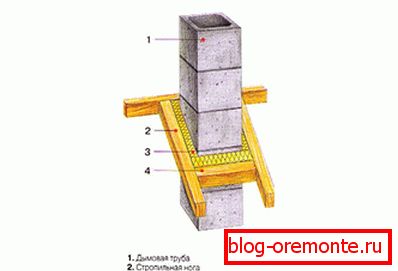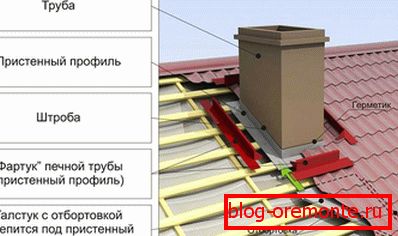How to properly remove the chimney
For the discharge of gases from the heating system is installed chimney, which is displayed on the street through the roof or through the wall. The passage through the roof is carried out with the device channel simultaneously with the construction of the building. When replacing the heating source, a situation arises when it is more expedient to move the chimney through the wall. For each method there are rules and regulations governing how to properly remove the chimney.
Roof installation site

The optimum place for a pipe through the roof will be located at a distance of up to 1.5 meters from the ridge. Stoves and roofers are unanimous in recommending this location because it has several advantages:
- There is no need to build a high pipe, which means minimal wind load and rare condensation.
- In winter, a small amount of snow accumulates around the structure and no leakage occurs.
Note! If the pipe is installed three meters from the ridge, according to the rules of the SNiP, its upper edge should be flush with the ridge. When making the design further three meters, between its top and the line of the ridge should not form an angle of more than 10 degrees. A pipe with a height of 0.5 to 1 meter is installed on a flat roof.
For the installation of the chimney do not recommend endy, where at the inner corner of the junction of adjacent ramps it is difficult to perform a high-quality abutment of the pipe, excluding water leakage. When located under the roof of a residential attic can not arrange a pipe near its windows, the wind will direct the smoke in their direction.
Choice of passage design

The design of the unit through which the chimney is discharged depends on the pipe material. Common types include brick, stainless steel, galvanized steel, ceramics. The choice of material is determined by the type of fuel used, if a high temperature gas is released during combustion, which causes the chimney to overheat, the metal cannot be used. Its high thermal conductivity contributes to the heating of the surrounding structure and can cause a fire. The chimney for this type of fuel has thick walls, and the top is equipped with a spout. Steel chimneys installed at a flue gas temperature below 400? C.

The shape of the chimney also matters, the popular options are the square and rectangular chimney. This choice is due to the availability of ready-made additional elements used for the passage device. Type of roofing is one of the most important factors.
Note! Depending on the resistance of the roof to the fire, the size of the fire gap is selected. For combustible materials it is 13–20 cm.
Smoke box

Any roof incorporates a layer of steam and waterproofing. The integrity of the canvases depends on the tightness of the roof, the absence of leaks and wet insulation. Removal of the chimney through the roof requires the creation of a hole in the roof, which includes not only the size of the pipe, but also the fire protection distance to the batten and the roofing pie, as defined by the relevant standards.
Note! The best solution would be to make the box in the passage.

The location of the junction of the chimney is limited on the sides by rafter legs, the upper and lower parts are made of transverse beams, selected by the size of the rafters. After making the box, the roofing pie is cut on the principle of an envelope. The edges of the paintings of steam and waterproofing lead on rafters and beams and fasten with nails or staples. In addition, their edges are glued with adhesive tape. Insulation failure must be compensated for by carefully sealing its edges. With further finishing of the attic, waterproofing will be pressed against the battens.

The free space between the pipe and the box is filled with fireproof insulation. The tightness of the passage of the pipe is provided by the installation of the apron. Its upper part is laid outside and is placed under the roofing material.
Insulation стыков

For the output of round pipes, a ready-made soft penetration of silicone or rubber with a flange attached to the slope is used. The element has different sizes and it is easy to pick it up to the diameter of the pipe. Silicone seal is suitable for any slope of passage. Such option is suitable for the metal pipe which is not heating above 100? C. With a higher degree of heating is used metal cup with a skirt, which is put on the pipe. The skirt is fastened with screws to the roof. The skirt is covered with roofing material with obligatory gluing with sealant. The passage of the brick pipe is closed by elements that come complete with roofing material.

Sealing the joint of the pipe and natural tile is carried out with the help of an elastic tape, which contains aluminum and lead. The bottom side with adhesive is applied to the bottom of the pipe and to the roof. On the pipe it is fixed with a metal strip, the upper edge of which is covered with a sealant. Connection with a soft roof is also insulated with an elastic band.
Output through the wall

When constructing a chimney, when the stove is located near a wall, it is easier to bring the gas discharge channel not through the roof, but through the wall. This design has its advantages:
- space saving;
- installation availability;
- roof tightness is not damaged.

Among the minuses can be noted:
- the need for insulation;
- loss of part of the heat leaving the chimney;
- the presence of a horizontal plot that negatively affects cravings.
Installation

The diameter of the chimney depends on the power of the heating boiler, and the height takes into account the optimum level of thrust. The design of this model of the chimney consists of an external vertical channel and a horizontal chimney connecting the outer pipe and the boiler. Work begins with the selection of the place where the pipe leaves the room. The hole in the wall is made to the size of the channel plus insulation. The horizontal pipe is connected to the boiler using standard transition elements and passes through the wall at an angle of 90 ?. On the wall, it is fixed with special brackets. Docking with the outer channel is performed at an angle of 90 ?. Installing a tee with a cleaning glass and a tube for draining condensate will provide the possibility of cleaning and trouble-free operation. As a chimney, a low-cost single-loop system with one stainless steel wall or double-circuit is used - an optimal device with a thermal insulation layer between two pipes. Such a system is protected from damage and provides an adequate level of fire safety.

The outer pipe is evenly fixed 1–2 meters to the wall; for this purpose, metal brackets are used.
Note! The place where a horizontal pipe passes through a wooden wall is necessarily insulated with heat-resistant material - asbestos fiber, steel.
Video
How to install the chimney through the finished roof, see below:
Pay attention to our other articles:
Soot Chimney Cleaning
What is a flexible chimney
How to gill flue